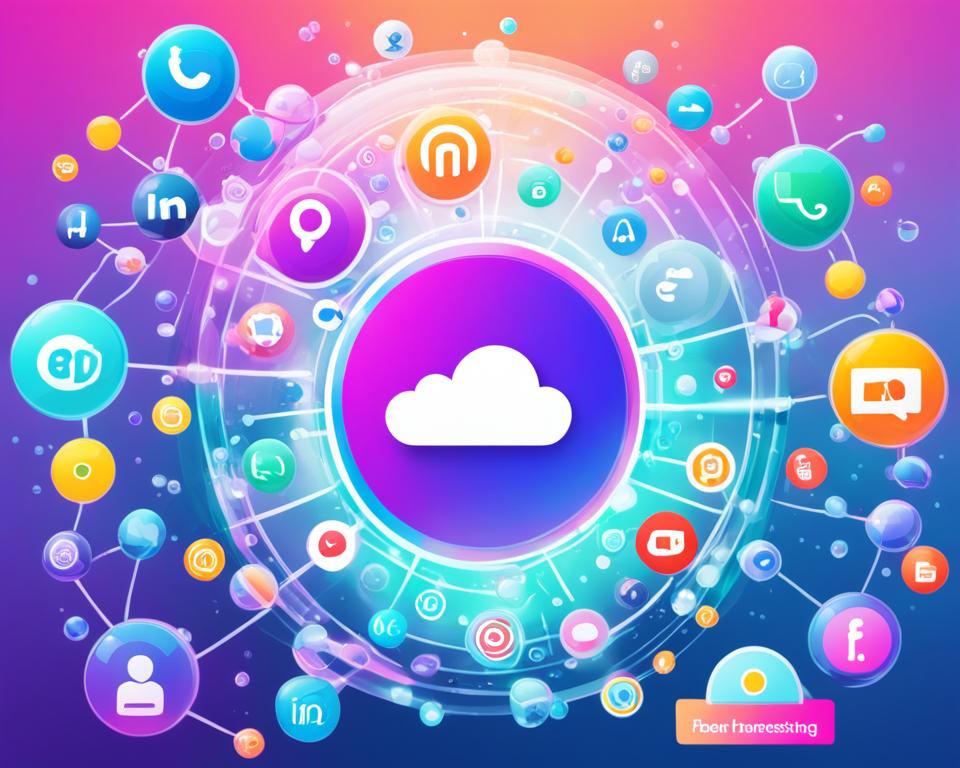Welcome to our article series on building a strong and successful brand in Indonesia through digital marketing. In today’s fast-paced online landscape, it is essential for businesses to harness the power of digital marketing strategies to thrive in a competitive market. By utilizing effective digital marketing techniques, you can elevate your brand’s visibility, engage with your target audience, and drive substantial growth.
Digital marketing encompasses a wide range of strategies and tactics, such as search engine optimization (SEO), social media marketing, content creation, online advertising, and web analytics. These techniques work together to create a comprehensive marketing approach that maximizes your brand’s online presence and connects with your audience in meaningful ways.
In this article, we will delve into various aspects of digital marketing, providing valuable insights and practical tips to help you establish a brand that stands out from the competition. From understanding the role of SEO in driving organic traffic to leveraging the power of social media marketing, content creation, online advertising, and web analytics, we’ll cover it all.
So, whether you are a startup looking to establish your presence or an established business aiming to expand your reach, our expert guidance on digital marketing will empower you to build a strong and successful brand in Indonesia. Let’s dive in and explore the exciting world of digital marketing strategies.
Understanding Digital Marketing
Before we dive into the strategies and techniques of digital marketing, it is essential to have a clear understanding of what it entails. Digital marketing encompasses various elements that work together to promote a brand, attract customers, and drive growth in the online space.
These elements include:
- Search Engine Optimization (SEO) – Optimizing your website’s content and structure to improve its visibility on search engine results pages and drive organic traffic.
- Social Media Marketing – Utilizing social media platforms to engage with your audience, build brand awareness, and drive website traffic.
- Content Marketing – Creating and sharing valuable content such as blog posts, videos, and infographics to attract and retain your target audience.
- Online Advertising – Leveraging paid advertising channels such as Google Ads, social media ads, and display ads to reach and convert potential customers.
- Search Engine Marketing (SEM) – Using paid search advertising to improve your brand’s visibility on search engine results pages.
- Email Marketing – Utilizing email campaigns to nurture leads, build customer relationships, and drive conversions.
- Web Analytics – Tracking and analyzing website data to gain insights into user behavior, campaign performance, and overall digital marketing effectiveness.
Gaining a Competitive Edge
In today’s digital landscape, understanding and implementing these elements of digital marketing can give your brand a competitive edge. Each element contributes to a comprehensive and integrated approach that allows you to connect with your target audience, establish brand authority, and drive measurable results.
“Digital marketing is not just about being present online; it’s about utilizing the right channels and strategies to stand out among the competition and achieve your business goals.”
Now that we have a grasp of the various components of digital marketing, let’s dive deeper into the role of SEO and how it can enhance your brand’s online presence and visibility.
The Role of SEO in Digital Marketing
In the world of digital marketing, search engine optimization (SEO) plays a crucial role in enhancing a brand’s visibility on search engine results pages. With the ever-growing competition in the online landscape, it has become essential for brands to optimize their websites and content to rank higher on search engines. In this section, we will delve into the importance of SEO in driving organic traffic to websites and provide valuable tips on optimizing content and website structure to improve search engine rankings.
Driving Organic Traffic with SEO
SEO is the process of optimizing a website to improve its visibility and organic traffic from search engine results. By aligning your brand’s website and content with search engine algorithms, you can increase the chances of appearing on the first page of search results. This high visibility translates into more visits, leads, and conversions for your brand.
When users search for information, products, or services related to your industry, effective SEO strategies can ensure that your brand’s website appears among the top search results. This visibility significantly increases the likelihood of attracting qualified organic traffic, as users tend to trust and click on the top-ranking websites.
Optimizing Content for Search Engines
One of the key components of SEO is optimizing the content on your website to align with search engine algorithms. By targeting relevant keywords and providing high-quality, valuable content, you can improve your website’s chances of ranking higher in search results.
To optimize your content for search engines, consider the following:
- Perform keyword research to identify the most relevant and popular keywords in your industry.
- Incorporate these keywords naturally throughout your website content, including headings, subheadings, and body paragraphs.
- Create informative and engaging meta tags, including title tags and meta descriptions, that accurately describe your content and entice users to click.
- Ensure your website is user-friendly and responsive, providing a seamless experience across devices.
By implementing these strategies, you can enhance your website’s SEO and increase its visibility to potential customers.
“SEO is not just about optimizing your website for search engines; it’s also about optimizing it for your target audience.”
Optimizing Website Structure
In addition to optimizing content, focusing on the structure and technical aspects of your website is vital for SEO success. A well-structured website not only enhances user experience but also allows search engine crawlers to navigate and index your content effectively.
To optimize your website structure and improve SEO:
- Create a clear and intuitive site navigation that allows users and search engines to easily explore your website.
- Ensure quick and efficient website loading speed by optimizing images, minimizing code, and leveraging caching.
- Implement proper URL structure, using descriptive and keyword-rich URLs that make it easier for users and search engines to understand your content.
- Optimize your website for mobile devices, as mobile-friendliness is a significant ranking factor for search engines.
By investing time and effort in optimizing the structure of your website, you can improve its crawlability and user experience, ultimately boosting its SEO performance.
In the next section, we will explore the power of social media marketing and how it can amplify your brand’s reach and engage your target audience.
Leveraging Social Media Marketing
Social media has revolutionized the way brands connect with their audience and establish brand awareness. In today’s digital landscape, social media marketing is an essential component of any successful digital marketing strategy. By effectively leveraging social media platforms, brands can engage with their target market, foster customer loyalty, and drive conversions.
When it comes to social media marketing, it’s crucial to have a comprehensive understanding of the different platforms available and how to utilize them to maximize results. In this section, we will explore some of the most popular social media platforms in Indonesia and discuss effective strategies for social media marketing.
1. Facebook
With over 155 million users in Indonesia, Facebook is undoubtedly a powerhouse in the social media landscape. It offers extensive targeting options, allowing brands to reach specific demographics, interests, and behaviors. Facebook provides excellent opportunities for content creation, community engagement, and paid advertising.
2. Instagram
Instagram boasts over 190 million active users in Indonesia and is a highly visual platform. Brands can showcase their products or services through captivating visuals and storytelling. Utilizing features such as Instagram Stories and IGTV can help create an immersive brand experience. Influencer collaborations and hashtags play a significant role in amplifying brand visibility on Instagram.
3. Twitter
Twitter’s fast-paced nature lends itself well to real-time updates, news, and customer support. It allows brands to engage in conversations with their audience, build brand credibility, and promote relevant content. Hashtags and retweets help expand a brand’s reach and enhance discoverability on Twitter.
4. YouTube
YouTube is the go-to platform for video content, with over 100 million users in Indonesia. Brands can create engaging video content to entertain, educate, and inspire their audience. YouTube ads enable targeted promotion, while collaborations with popular creators can enhance brand association and reach.
5. LinkedIn
LinkedIn is a professional networking platform with over 21 million users in Indonesia. It caters to B2B businesses, job seekers, and professionals. Brands can utilize LinkedIn for thought leadership, industry insights, and targeted advertising to reach decision-makers and professionals.
“Social media allows us to connect with our audience on a more personal level and create meaningful relationships. It’s not just about promotional content but also about engaging and providing value to our followers.” – Jane Smith, Digital Marketing Manager at XYZ Company
When developing a social media marketing strategy, it’s crucial to consider the following:
- Identifying your target audience and selecting the most relevant platforms
- Developing a content strategy that aligns with your brand and resonates with your audience
- Engaging with your audience through meaningful conversations, comments, and direct messages
- Utilizing paid advertising options to amplify reach and drive conversions
- Monitoring and analyzing social media metrics to understand the effectiveness of your efforts
By leveraging social media marketing effectively, brands can enhance their online presence, build brand loyalty, and cultivate a strong community of engaged followers.

| Social Media Platform | Number of Users in Indonesia |
|---|---|
| 155 million | |
| 190 million | |
| N/A | |
| YouTube | 100 million |
| 21 million |
Creating Engaging Content Marketing Strategies
In the world of digital marketing, content is king. Compelling and valuable content plays a crucial role in attracting and retaining a target audience. Through content marketing, brands can establish themselves as thought leaders, build trust with consumers, and drive conversions. In this section, we will explore different types of content marketing and provide insights on creating engaging and shareable content that resonates with your audience.
Types of Content Marketing
Content marketing encompasses a wide range of formats, each serving a specific purpose and offering unique benefits. Brands can leverage various types of content marketing to capture the attention of their target audience:
- Blog Posts: Relevant and informative blog posts can establish your brand as an industry expert and provide valuable insights to your audience.
- Videos: Engaging video content has become increasingly popular, allowing brands to deliver their message in a dynamic and visually appealing manner. Videos can include tutorials, product demonstrations, or brand stories.
- Infographics: Visual content such as infographics presents complex information in a visually appealing and easy-to-understand format. Infographics can be highly shareable, increasing brand visibility and reach.
By diversifying your content marketing strategy and utilizing different formats, you can cater to the preferences of your target audience and increase engagement with your brand.
The Art of Creating Engaging Content
Creating content that captivates your audience requires a thoughtful and strategic approach. Here are some tips to help you craft engaging content:
“Good content is not storytelling. It’s telling your story well.” – Ann Handley
- Know Your Audience: Understanding your target audience’s needs, preferences, and pain points is essential for creating content that resonates with them. Conduct audience research and develop buyer personas to guide your content creation process.
- Tell Compelling Stories: Storytelling is a powerful tool for capturing attention and evoking emotions. Craft narratives that align with your brand values and mission, creating a connection between your audience and your brand.
- Provide Value: Your content should offer valuable insights, information, or entertainment to your audience. Aim to educate, inspire, or solve a problem for them, positioning your brand as a trusted source of expertise.
- Utilize Visuals: Incorporating visually appealing elements such as images, graphics, and videos can enhance the impact of your content and make it more engaging. Visuals can help break up text and simplify complex concepts.
- Optimize for Search Engines: Implementing search engine optimization techniques in your content can improve its visibility on search engine results pages. Conduct keyword research and optimize your content with relevant keywords, meta tags, and headings.
With these strategies in mind, you can create content that not only attracts your target audience but also compels them to take action and engage with your brand.
Harnessing the Power of Online Advertising
Online advertising plays a vital role in digital marketing, enabling brands to effectively reach their target audience through various paid channels. Platforms such as Google Ads, social media ads, and display ads provide the opportunity to enhance brand visibility and increase conversions. By strategically utilizing online advertising, brands can engage with potential customers and drive website traffic.

The Various Online Advertising Platforms
When it comes to online advertising, there is an array of platforms to choose from. Each platform offers unique features and advantages, allowing brands to tailor their advertising strategy to their specific goals and target audience:
- Google Ads: With Google Ads, brands can display their ads on search engine result pages and other websites in the Google Display Network. This platform offers various targeting options, including keywords, demographics, and interests.
- Social Media Ads: Social media platforms like Facebook, Instagram, Twitter, and LinkedIn provide extensive advertising opportunities. Brands can create highly targeted ads based on user demographics, interests, and behavior.
- Display Ads: Display ads are visual advertisements that appear on websites, apps, and other digital platforms. This form of advertising includes banner ads, pop-ups, and video ads, allowing brands to capture their audience’s attention.
Strategies for Maximizing Ad Visibility and Conversions
To ensure optimal results from online advertising campaigns, it is essential to implement effective strategies. Here are some strategies to harness the power of online advertising:
- Targeting: Define your target audience and carefully select targeting options to reach the right people with your ads.
- Compelling Ad Copy: Craft compelling ad copy that clearly communicates your brand’s message and encourages users to take action.
- Visual Appeal: Use visually appealing images or videos that grab attention and align with your brand’s visual identity.
- Call-to-Action: Include clear and persuasive calls-to-action in your ads to prompt users to click or make a purchase.
- A/B Testing: Experiment with different ad variations to identify the most effective elements and optimize your campaigns for better results.
- Tracking and Analytics: Regularly monitor the performance of your online advertising campaigns using tracking and analytics tools. Adjust your strategies based on the data to improve ad visibility and conversions.
By implementing these strategies and staying up-to-date with the latest trends and developments in online advertising, brands can maximize their ad reach, enhance brand awareness, and drive conversions.
| Benefits of Online Advertising | Challenges of Online Advertising |
|---|---|
| 1. Increased brand visibility | 1. Ad saturation |
| 2. Precise targeting | 2. Ad blocking |
| 3. Cost-effective compared to traditional advertising | 3. Competition for ad space |
| 4. Better tracking and analytics | 4. Ad fatigue |
| 5. Flexibility and scalability | 5. Ad fraud |
Measuring Success with Google Analytics and Web Analytics
Tracking and analyzing data is essential to measure the success of digital marketing efforts. By utilizing tools like Google Analytics and Web Analytics, brands can gain valuable insights into website performance and campaign effectiveness. In this section, we will provide an overview of these analytics tools and explain how to set up goals and track key metrics for optimal decision-making and strategic improvements.
Understanding Google Analytics
Google Analytics is a powerful web analytics tool provided by Google that helps businesses track and analyze website traffic, user behavior, and conversion rates. By implementing Google Analytics on your website, you can gain deep insights into how users interact with your site and make data-driven decisions to optimize your digital marketing strategies.
“Google Analytics allows us to understand our audience better and identify areas for improvement in our digital marketing campaigns. Tracking metrics such as website traffic, bounce rate, and conversion rates helps us make informed decisions and refine our strategies.”
Setting Up Goals and Tracking Metrics
Setting up goals in Google Analytics is crucial for tracking the success of your digital marketing campaigns. Goals can be defined as specific actions you want users to take on your website, such as making a purchase or completing a contact form. By configuring goal tracking, you can monitor conversions and analyze the effectiveness of your marketing efforts.
| Key Metrics | Description |
|---|---|
| Visitors | The total number of unique users who visit your website. |
| Pageviews | The total number of pages viewed by users on your website. |
| Bounce Rate | The percentage of users who leave your website without interacting further. |
| Conversion Rate | The percentage of website visitors who complete a desired action (e.g., purchase, form submission). |
Using Web Analytics Tools
In addition to Google Analytics, there are various web analytics tools available that can provide valuable insights into website performance. These tools offer features and functionalities beyond basic metrics tracking, allowing you to delve deeper into user behavior and optimize the user experience.
“Web analytics tools give us a comprehensive view of our customer journey and help us identify areas of improvement. With these insights, we can tailor our digital marketing strategies to match user preferences and drive better results.”
Web analytics tools can track metrics such as average session duration, click-through rates, and conversion funnels, providing a holistic view of your website’s performance and user engagement. Some popular web analytics tools include:
- Adobe Analytics
- Kissmetrics
- Heap Analytics
- Matomo
By employing these tools and analyzing the data they provide, you can make data-driven decisions, optimize your digital marketing efforts, and ensure you are on the right track to achieving your business goals.
Track your digital marketing success with Google Analytics and web analytics tools, harnessing the power of data-driven insights. These analytics tools empower brands to make informed decisions, refine strategies, and optimize website performance.
Conclusion
In today’s competitive online landscape in Indonesia, digital marketing is the key to building a successful brand. By implementing strategic techniques such as SEO, social media marketing, content marketing, online advertising, and web analytics, brands can thrive and achieve their goals.
SEO, or search engine optimization, improves a brand’s visibility on search engine result pages, driving organic traffic to websites. Social media marketing allows brands to engage with their audience through various platforms, building brand awareness and loyalty. Content marketing creates valuable and relevant content, attracting and retaining the target audience. Online advertising enables brands to reach their target audience through paid channels, maximizing visibility and conversions. Web analytics and tools like Google Analytics provide valuable insights into website performance and campaign effectiveness, allowing brands to make data-driven decisions.
To truly succeed in the digital age, it is crucial to invest in digital marketing. With the right strategies and techniques in place, brands can not only survive but thrive, capturing the attention and loyalty of their target audience. Take the leap today and leverage the power of digital marketing to take your brand to new heights in Indonesia.
FAQ
How can digital marketing strategies help in building a strong brand?
Digital marketing strategies can help in building a strong brand by increasing brand visibility, reaching a wider audience, and engaging with consumers on various online platforms. It allows brands to showcase their unique value propositions and build lasting relationships with customers.
What is digital marketing?
Digital marketing refers to the use of digital channels and technologies to promote products or services and build brand awareness. It encompasses various methods such as search engine optimization (SEO), social media marketing, content marketing, online advertising, email marketing, and web analytics.
How does SEO contribute to digital marketing?
SEO plays a crucial role in digital marketing by improving a brand’s visibility on search engine results pages. It helps increase organic traffic to a website, enhances brand credibility, and boosts conversions. By optimizing content and website structure, brands can achieve higher search engine rankings and attract more relevant visitors.
What are some effective social media marketing strategies?
Effective social media marketing strategies include creating engaging content, building a strong social media presence, fostering relationships with followers, and leveraging paid advertising options. Brands should regularly post high-quality content, listen to their audience, and actively engage with them to build brand loyalty and increase reach.
What is content marketing and how can it benefit a brand?
Content marketing involves creating and distributing valuable, relevant, and consistent content to attract and retain a target audience. It benefits a brand by establishing thought leadership, increasing brand visibility, driving organic traffic, and nurturing customer relationships. Well-executed content marketing can position a brand as an industry authority and generate leads.
How can online advertising help in reaching a target audience?
Online advertising allows brands to reach their target audience through paid channels such as search engines, social media platforms, and display networks. By strategically targeting specific demographics, interests, and behaviors, brands can maximize ad visibility and increase the chances of reaching potential customers who are more likely to convert.
What are Google Analytics and web analytics?
Google Analytics and web analytics are tools used to track and analyze website performance and marketing campaigns. Google Analytics provides valuable insights into website traffic, user behavior, and conversions. Web analytics, in general, measures website performance, analyzes user data, and helps marketers optimize online strategies to achieve specific goals.





